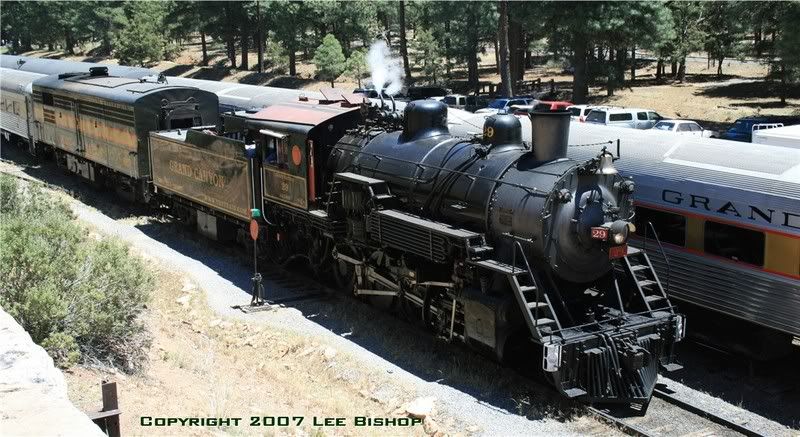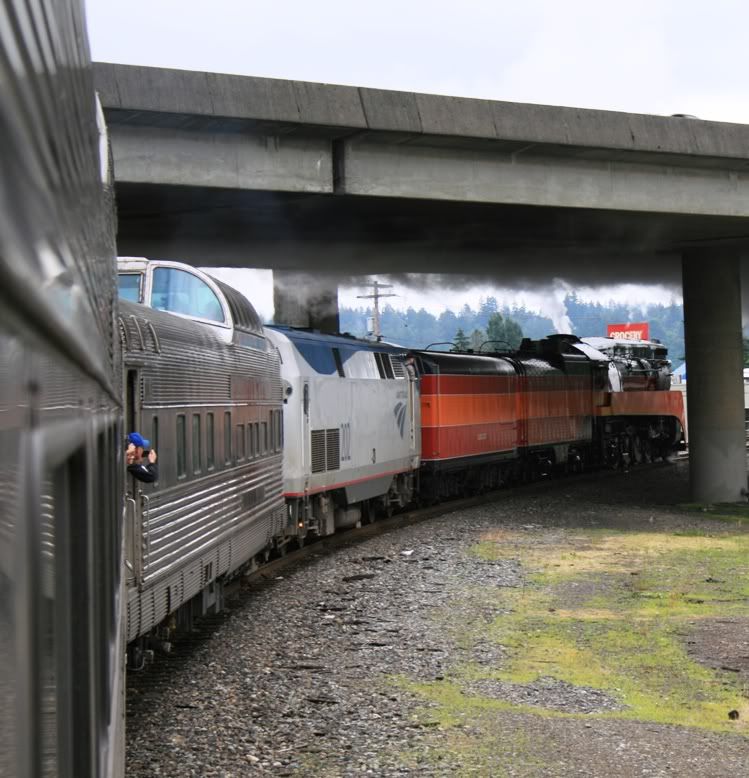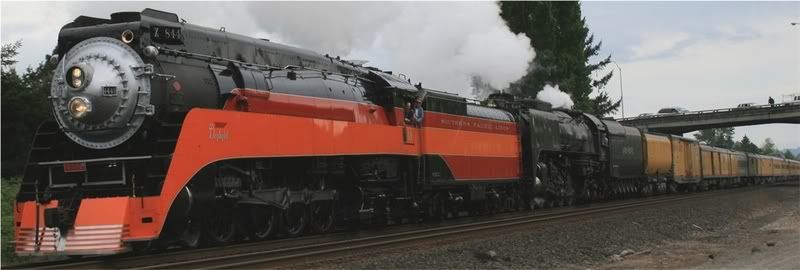I've noticed some steam excursion trains will have a diesel locomotive behind the steam one. Seems to me when I was younger 10-15 years ago, the steam locomotives operated by themselves. Is the diesel there for safety or pulling power?
Replies sorted oldest to newest
I think it is a little more complicated than just those two categories: Safety or pulling power.
My first two answers are: Head End Power, and Dynamic Brakes.
Many different reasons. Sometimes, if the train is run under Amtrak, the diesels are there to cover their butt and sometimes to provide head end power for the passenger cars. Sometimes it is there to help get the trains up big grades, like NS has done when using smaller steamers. Sometimes it is used to extend coal and water stops, sometimes to just get the train over the road faster, ala 765 up Horseshoe Curve, sometimes maybe because the host railroad doesn't trust the steamer to not break down, and sometimes because your boiler is so full of mud your steamer won't make any power, ala UP 844.
I would guess." in case of a break down." No need to tie up the railroad for any length of time.
"d" all of the above.
One more reason - to stretch the coal on long moves, as filling the tender is a long process and the last thing you want to do is tie up the railroad.
It IS worth noting that except when diesels were added for VERY specific reasons, 765 has had the free run of NS for several years.
All good answers above, plus it is preferable to let the diesel do the work when transiting long tunnels, for obvious reasons...
Add in free advertising for the host road.
Back when the 844 and 3985 were PROPERLY maintained and operated, the Union Pacific had absolute Faith in them, and they ran many, many miles unassisted. When they came out to Portland, OR, they would get a diesel cut in behind the steam running through the Blue Mountains of Eastern Oregon. While talking to the crew while the 844 was stopped in La Grande, OR I asked about that, and the reply was that the 844 was fully capable of pulling the grades, but the diesel was there for Dynamic braking, on the descending grades.
Sure enough, when I saw the 844 making time westbound through the Columbia River Gorge, she was again in sole command of her train. Seeing the 844 running solo, at track speed in the Columbia River Gorge, was about as Pretty a sight as a railfan can Hope to see.
Doug
Added note: 3985 is headed north out of Klamath Falls Oregon on 9-7-2005 and in a few hours will be descending 40-odd miles of continuous grade from Cascade Summit, averaging about 1.7%.You can bet that the diesels will be in dynamic braking on that long downgrade.
Attachments
Primary reasons:
- Stretch the coal
- Head End Power
Secondary reasons:
- Additional tractive power (steep grade, big train, small locomotive)
- Mechanical reliability concerns
- Tunnels
Non Reasons:
- Advertising
- Braking power
- Safety
When I first saw this topic I never gave tourist trains a thought.
My hometown is in Ohio where the original B&O crossed the Ohio River between Bellaire, Ohio and Benwood, West Virginia.
There are/were grades up from both sides of the river to @ the center of the bridge. There are photos that clearly show this.
My first sighting of Diesels on this bridge were when they were being used as helpers. An A-A set would cross the bridge
and a short time later they would return on the point of a freight train. They would also lead a train from West Virginia
to Ohio and return alone. A roundhouse and yards was on the West Virginia side. These certain helpers were only used
for crossing the bridge.
As more Diesels became available the roles reversed and soon steam was gone.
Freight trains in this area were all Dieselised before passenger trains.
After the IC crew forgot to tell the AFT 4449 Crew on the Amtrak Transcon steam trip in 1977 about the 20 MPH crossover switches on the main, the 4449 had trouble with some of her tubes. IC placed some Geeps in front of the train to NOLA. On the Sunset Route out of NOLA, there was still trouble with the engine. There was an SP six axle diesel placed behind the 4449 all the way to Houston, and if I remember, on the way to San Antonio. HW can fill in and correct. The MU box first developed for the AFT 4449 comes in handy in a situation like this.
During the AFT, the railroad it would be running on would place a bi-cent diesel behind her .
I remember seeing the opposite on film once - a Reading T1 in the rear as a pusher on a coal drag. I guess pretty much anything you can think of has actually happened at least once in reality.
-Greg
Dominic Mazoch posted:During the AFT, the railroad it would be running on would place a bi-cent diesel behind her .
The AFT left Chicago on both the C&NW and BN "under it's own steam" with no diesel "helpers," bicentennial or otherwise, behind 4449.
Rusty
Schnucks posted:I've noticed some steam excursion trains will have a diesel locomotive behind the steam one. Seems to me when I was younger 10-15 years ago, the steam locomotives operated by themselves. Is the diesel there for safety or pulling power?
Over the many decades of steam excursions, the use of a diesel "helper" behind the steam locomotive has changed. Here are some key reasons for the "diesel behind the steam" in more recent times:
1) If the trip involves a heavy train with long ascending and descending "mountain grades", then the diesel is especially handy for dynamic braking on the long descending grades, even if the steam locomotive is capable of handling the train unassisted on the ascending grades.
2) For even steeper ascending grades, the diesel may be required for assistance with a long/heavy passenger train.
3) ANY steam excursion that is operated under Amtrak, with Amtrak liability insurance coverage, will have an Amtrak diesel MU'ed behind the steam locomotive in order to supply 480 volt, 3 phase HEP power to the passenger cars. Doesn't matter whether the Amtrak diesel is used for tractive assistance or not, HEP is the REQUIREMENT.
) If the trip involves a heavy train with long ascending and descending "mountain grades", then the diesel is especially handy for dynamic braking on the long descending grades, even if the steam locomotive is capable of handling the train unassisted on the ascending grades.
HW how would you do that? would there be have a second engineman on the diesel controlling the dynamic brake. Who would have control of the trains' air brakes? steam crew?
Gregg posted:) If the trip involves a heavy train with long ascending and descending "mountain grades", then the diesel is especially handy for dynamic braking on the long descending grades, even if the steam locomotive is capable of handling the train unassisted on the ascending grades.
HW how would you do that? would there be have a second engineman on the diesel controlling the dynamic brake.
Yes.
Who would have control of the trains' air brakes? steam crew?
Absolutely! The locomotive in the lead MUST control the automatic air brakes. In those cases of VERY sever mountain grades on the "old" Southern Pacific RR, we always added the diesel helpers on the front of 4449, in those areas of normal helper districts. Thus, the diesel helper on the front was in the lead position, and had control of the automatic air brakes. Thus, in those normal helper districts, we would not have had to put up with the diesel MU'ed behind the steam locomotive, all day long, when it REALLY was not needed the rest of the trip.
Get rid of those stinking tin cans and let the steamer do its' job.![]()
Gregg posted:Get rid of those stinking tin cans and let the steamer do its' job.
I certainly agree! However, you haven't really lived until your steam locomotive has had to work at FULL THROTTLE through a 2 mile long tunnel/snow shed, as a result of the MU'ed diesel stopped loading from ground relay lock-out. Also, the dynamic brake assistance on long descending mountain grades sure is nice too.
I recall from magazine articles that Clinchfield #1 ran steam excursions in the 1970's with an F7B helper, because the steamer was a rather small loco. They used a remote control box for the diesel in the cab of the steamer, like a hostler's control which simply plugs into the MU connections. Some passengers thought the diesel was a baggage car.
Attachments
In the picture above, I don't think the diesels were there for any reason other than to show them off. The same was true when 765 ferried to St. Louis with the IT and Wabash heritage units in tow, although I think that time the diesels might have been used to pull back the employee excursions where there was no place to wye the train.
Dieselbob posted:In the picture above, I don't think the diesels were there for any reason other than to show them off.
I can show off more diesels than you can...![]()
Rusty
Attachments
Dieselbob posted:In the picture above, I don't think the diesels were there for any reason other than to show them off. The same was true when 765 ferried to St. Louis with the IT and Wabash heritage units in tow, although I think that time the diesels might have been used to pull back the employee excursions where there was no place to wye the train.
Actually, I believe Rich said they used the diesels to help stretch the coal supply on those NS trips.
2nd peek at the picture above, I didn't realize the train was heading over a crossover.
mlavender480 posted:Dieselbob posted:In the picture above, I don't think the diesels were there for any reason other than to show them off. The same was true when 765 ferried to St. Louis with the IT and Wabash heritage units in tow, although I think that time the diesels might have been used to pull back the employee excursions where there was no place to wye the train.
Actually, I believe Rich said they used the diesels to help stretch the coal supply on those NS trips.
They HAVE done that with 765, but I'm not sure the two trips mentioned were among them. When the St Louis train blew by me at 40 MPH, the diesels were idling IF they were running at all.
Attachments
All I've ever heard in recent years was if there were (Amtrak-certified, which is all you get to run on main lines these days) passenger coaches behind the power, their used diesels to run HEP. Back in the day, I heard the excuse for them was for backup in case the steam locomotive had an issue (ironically, as some steam locomotive issues would prevent the locomotive from moving at all, no matter what's coupled to the back of the tender).
The Grand Canyon ran steam daily a few years back, and it looked nice with FA B units for helpers, I thought...

Many excursions are Amtrak-run these days, and they require an Amtrak locomotive behind the steam locomotive.

But then, you have the UP ones, which in some cases don't have diesels:

p51 posted:But then, you have the UP ones, which in some cases don't have diesels:
Yes, prior to December 2010.
Hot Water posted:Gregg posted:Get rid of those stinking tin cans and let the steamer do its' job.
I certainly agree! However, you haven't really lived until your steam locomotive has had to work at FULL THROTTLE through a 2 mile long tunnel/snow shed, as a result of the MU'ed diesel stopped loading from ground relay lock-out. Also, the dynamic brake assistance on long descending mountain grades sure is nice too.
Was that when a GE died inside a tunnel on Donner Pass?
Dominic Mazoch posted:Hot Water posted:Gregg posted:Get rid of those stinking tin cans and let the steamer do its' job.
I certainly agree! However, you haven't really lived until your steam locomotive has had to work at FULL THROTTLE through a 2 mile long tunnel/snow shed, as a result of the MU'ed diesel stopped loading from ground relay lock-out. Also, the dynamic brake assistance on long descending mountain grades sure is nice too.
Was that when a GE died inside a tunnel on Donner Pass?
Correct!!!!! The ground relay tripped just going into the tunnel, then the heat/exhaust gasses from 3985 killed the diesel in the MU'ed GE unit. The folks in the cab of that GE unit were in trouble when their air condition quit, and they had so many pieces of luggage against the electrical cabinet doors, that they couldn't open the doors and first, couldn't reset the locked out ground relay, and second restart the diesel engine when it choked & died.
Hot Water posted:p51 posted:But then, you have the UP ones, which in some cases don't have diesels:
Yes, prior to December 2010.
See, this stuff changes all the time. I'm not surprised at all to read that...
Dieselbob posted:In the picture above, I don't think the diesels were there for any reason other than to show them off.
Correct.
The Harrisburg trips were short ones and no diesel "help" was needed for tractive effort of stretching the coal. Just a little PR for the railroad.








